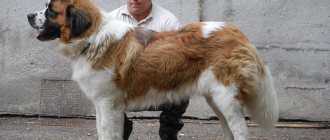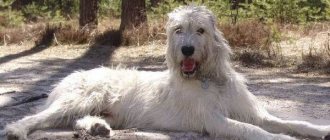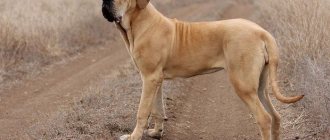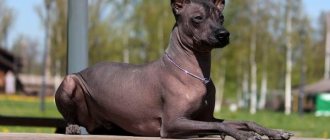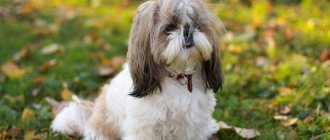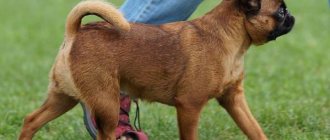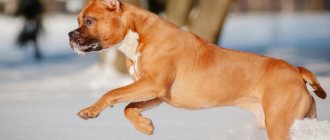Appearance and characteristics of the breed
A typical representative of the breed is large, massive, tall and broad-bodied. Anyone who has seen a “Muscovite” will confirm: the dog has an intense gaze, a specific facial expression and a very beautiful exterior.
As for character traits, the Moscow Watchdog was once considered one of the most vicious and distrustful breeds. At least the dogs treated strangers in this way; they were obedient and even affectionate with their owners.
Today's “Muscovites” differ in character from their ancestors. Most dogs have forgotten what aggressive behavior towards strangers is.
A dog for the elite
Research has revealed that only an authoritarian, intelligent extrovert with a balanced psyche can properly raise such a dog.
According to observations, bitches serve more diligently, but do not recognize the authority of family members, considering only the owner to be the leader. At the same time, males are prone to conflicts and fights.
History of the origin of the breed
It all started after the Great Patriotic War, when the ranks of service dogs were significantly reduced, to the point of complete loss. The USSR Ministry of Defense gave the order: to get our own, Russian breed of service dogs. According to superiors, the breed must have malice and distrust of strangers, work in any conditions and withstand the most persistent frosts.
No sooner said than done, the work began in 1947, in the famous nursery “Red Star”. Professor-biologist N.A. Ilyin, Major General, commander of the Central School of Military Dog Breeding at the kennel, G.P. Medvedev and the head of the breeding nursery N.I. Bortnikov became the “fathers” of a new breed.
With the help of interbreeding, three years after the start of work, the first litter that met the necessary requirements was presented at the exhibition. Six littermates - five males and a female, obtained from the mating of a St. Bernard and a Caucasian Shepherd, received descriptions that were taken into account in further work on the breed.
Dog breeders have been working on the breed for a long time. By the mid-50s of the last century, the exterior of the Moscow watchdog became almost the same as they were used to seeing 30 years later.
The Moscow Watchdog is a factory breed based on St. Bernard mestizos, Russian piebald hounds, East European and Caucasian shepherd dogs.
Kinds
There is only one species - the Moscow Shepherd guard dog , but to consolidate the differences with relatives, a few words about the ancestors.
- Caucasian Shepherd Dog. One of the breeds bred in Russia. Or rather, it originates from antiquity, from the Molossians, but breeding work began at the beginning of the 20th century. The range of modern dogs is areas close to the Caucasus Range. Height at the withers is up to 75 cm, weight up to 70 kg, but can reach up to 110 kg. Considered one of the largest dogs in the world.
The coat is thick, with undercoat. There are three varieties: long-haired, medium-haired and short-haired. The fur color is closer to wolf, gray-brown-fawn. The ears must be cropped, since the dog’s main job is as a shepherd, protecting the herd from predators. And the ears get in the way in a fight.
The character is courageous, decisive, distrustful of strangers. Distinctive qualities are fearlessness and anger. But the owner is the most important being in his life. The dog is literally ready to give his skin for him.
Caucasian Shepherd, one of the largest dog breeds
- Saint Bernard In appearance, the Muscovite is most similar to this breed. But it weighs a little less. The difference in height is not very noticeable, the Swiss at the withers is up to 70 cm, but his weight is much greater - by 10-15 kg. The name comes from the monastery of St. Bernard in the Alps. There is information that this monk organized a shelter for lost wanderers in the mountains. And local dogs helped him find travelers frozen in the snow.
Subsequently, the monks of that monastery often used the “dogs of St. Bernard” to detect people in avalanches. And now the main purpose of the dog is as a search and rescuer. After an avalanche, the St. Bernards are provided with the necessary equipment, food, water, clothing, and sent to look for people in the thick snow. And they really saved the lives of hundreds of victims. This is largely due to the dog’s glorious character. He is obedient, devoted, loves all people, and is very careful in his handling.
The St. Bernard is very similar in appearance to the Moscow Watchdog, but the breeds also have differences
Diseases and health problems
When dog breeders worked on the breed, any marriage was mercilessly destroyed. The health of the dogs was especially carefully monitored; sick animals were subject to culling.
In this regard, most of the Moscow watchdogs are a healthy, strong breed. The main health problems are common and not specific to this breed:
- Aujeszky's disease or pseudorabies is an infectious disease of all animal species, accompanied by pulmonary edema, damage to the central nervous system, itching and scratching.
- Viral enteritis is a disease that affects the small and large intestines, as well as the stomach.
- Parainfluenza is an acute infectious disease that affects the upper respiratory tract.
- Rabies is a fatal disease that is dangerous for both animals and humans.
- Hip dysplasia, common to almost all large breeds.
- Allergic reactions, including to food.
- Tendency to obesity.
The most interesting thing is the life expectancy of modern dogs. If earlier Moscow watchmen lived up to 14 years, now they live up to 9–12 years.
Price of puppies
How much does a Moscow watchdog cost? In a kennel, a puppy will cost an average of 20 thousand rubles, and for amateur dog handlers about 15 thousand rubles.
There are happy exceptions when, due to certain circumstances, the price can be reduced, for example, due to a promotion at the nursery or personal reasons with the seller - an individual.
Breed standard
The Moscow Watchdog is not approved by the FCI, which means that the standard refers only to the description of the RKF.
- The head is massive, large, proportional to the overall build, wide and deep in the skull.
- The muzzle is somewhat shorter than the skull, wide, blunt, deep, voluminous, well filled under the eyes. The lines of the forehead and muzzle are parallel.
- The ears are small, hanging on cartilage, triangular in shape with rounded ends, the front edge adjacent to the cheekbones, set above the eye line, with feathering.
- The eyes are small, dark, round in shape, deep, wide and straight, the expression of the eyes is calm and confident. The eyelids are black, dense, moderately dry.
- The nose is large, wide, black.
- The jaws are powerful and wide. The teeth are large, white, tightly adjacent to each other, 42 teeth in total.
- The body is solid, somewhat stretched, well balanced, proportional, voluminous, deep.
- The tail is wide, thick, reaching the hock joint in length.
- The coat is dense, long, thick, with a well-developed undercoat, and the guard hair is straight. The hair on the head and front of the legs is shorter. A slight wave in the coat is allowed in the area of the waist, croup and hips.
- The color is red-piebald, spotted: white with spots of red, red-black, black-red, sable, the presence of a red tint in the color is mandatory. A white chest, forelimbs to the elbow and hind limbs to the shin, and the end of the tail are required; specks on a white background of any of the listed colors, dark glasses, black on the ears are preferred. The desired color is as follows: a dark head, thanks to a black mask (full or without it), black glasses and ears, in contrast to a lighter colored body, with reddish spots separated from the white color by distinct sable borders.
- Height at the withers: for males not lower than 68 cm, for females not lower than 66 cm.
- Weight : males from 55 kg, females from 45 kg.
A dog with behavioral or conformation abnormalities is subject to culling and removal from breeding.
Character and habits
As a worthy service breed, the Moscow Watchdog has always had a strong character.
In the Land of the Soviets, dogs were left for service whose character was dominated by the habits of Caucasian Shepherds. Such “Muscovites” were extremely distrustful of outsiders, ferocious, and were considered excellent guards. Representatives of the breed with the character of St. Bernards, on the contrary, are overly kind and friendly.
Such animals are ideal for living in a home and participating in exhibitions; their protective qualities often leave much to be desired.
A properly raised and trained Moscow Watch dog can become an excellent companion and security guard. Animals treat their family members very well: they are affectionate and obedient. But true devotion is only to one person.
It is believed that “Muscovites” get along perfectly with children and allow them a lot. However, do not forget - this is a service dog with the appropriate inclinations, and not a nanny.
Character of the Moscow guard dog
The calculation of the Red Star specialists that their pets would inherit the aggression and impulsiveness of Caucasian wolfhounds was only partially justified. Yes, the Moscow watchmen are brave and courageous, but they are by no means evil and certainly not reckless. The dog will enter into conflict with anyone only when the enemy clearly demonstrates his own intentions. And yet the character of the Moscow watchdog is largely determined by genes. In particular, individuals with predominant blood of “Caucasians” demonstrate greater suspicion and ferocity. They are easy-going and much more suitable for the role of fearless bodyguards. Dogs that have inherited the St. Bernard's temperament are noticeably more phlegmatic, which is why such Moscow watchdogs are more often recommended for the role of family pets and guardians of the owner's wealth.
Raising a Moscow Guard Dog
Moscow watchmen are quiet and only speak when necessary. If your shaggy giant grumbles, it means he really got fed up. In a family, the dog behaves quite peacefully: this is due to the innate ability of “Muscovites” to become attached to people with whom they have to share a common territory. The Moscow watchdog also does not have any friction with children, however, provided that these are not the neighbor’s kids who ran in by chance. A properly raised animal will look at such guests with at least indifference, and even with outright dissatisfaction.
On the Internet you can find a lot of video evidence that Moscow watchmen make hyper-responsible nannies. But in reality, not everything is so simple. Of course, the “Muscovite” will be happy to take your heirs for a ride on a sled, play tag with them and even try to forgive them for minor pranks, but it’s still not worth going away for a long time and leaving foolish kids with such a giant. As an example: a random flick of the tail of this shaggy security guard can knock a three-year-old naughty boy off his feet.
Moscow watchdogs treat each family member equally equally. They do not divide household members into favorites and episodic characters and try to listen to each of them. But this does not mean that the MC is not able to guess who exactly is in charge in the house. Quite the opposite - a pet living in a family is always aware of who has the last word.
Moscow guard dog with a child
Care and maintenance
Once upon a time, Moscow guards were kept in apartments. But given the size of this breed, representatives of the breed are much more comfortable living in an enclosure than toiling around at home.
Therefore, the ideal solution would be a spacious enclosure on the site of your own home, quality outside walking and mandatory training classes.
"Muscovites" are unpretentious in maintenance, except for regular brushing. The coat tends to get tangled and fall into unsightly tangles. To prevent this from happening, the dog is brushed every two to three days, and during shedding - daily.
Minimum list required to keep a dog:
- An aviary and a booth with bedding in it.
- Bowls for food and water.
- High quality food.
- Leash and collar for walking.
- Toys.
- Treats.
- Nail clippers.
- Comb.
For show dogs, you will need a show ring, professional shampoos, classes with a handler, etc.
Breeding
Dogs of this breed under 2 years of age are considered not mature for mating. A bitch is not paired with a male dog during her first heat. The meeting usually takes place on the territory of the male.
With a successful mating, pregnancy occurs, which lasts about 2-2.5 months: the more puppies are expected, the earlier the birth occurs.
The Moscow Watchdog can bring up to 14 babies at a time.
From the 2nd month of pregnancy, the dog will need to increase the number of meals. If she lives in a booth, the size of which is not enough for the growing offspring, you need to temporarily transfer her to a more spacious, warm building or take her into the house.
Education and training
Here we come to the most important point - education and training. Raising a puppy begins from the first days in the house. For the first couple of months, it is better to keep the baby in the house, gradually accustoming him to the enclosure.
The owner's golden rule: consistency in actions.
A typical example: a puppy cries on the first night, the owner takes him to bed. The next night everything repeats, and then the dog quietly moves into the owner’s bed. There is no need to tell what rules will be displayed when moving into the enclosure.
In such a situation, you can and should approach the puppy, speak kindly to him, stroke him until he falls asleep, but firmly stand his ground and not take him to bed.
Yes, it is difficult to wake up several times a night, especially when you have to get up early for work in the morning. Taking a puppy to bed is much easier, it seems at first glance.
As for training, at the age of 2.5 - 3 months you can already invite a dog handler to your home or go to the dog playground.
The first trip to the site is carried out after the last vaccination and at least a three-day quarantine!
Vaccinations
Vaccinations protect your dog from most diseases. Vaccination of the Moscow watchdog is carried out at intervals:
- 1.5 months – first vaccination. Provides protection against plague, enteritis, hepatitis, adenovirus and leptospirosis.
- 2.5 – 3 months. 2 vaccinations are carried out at once. Vaccination against plague, enteritis, hepatitis, adenovirus and leptospirosis is repeated. In addition, the puppy is vaccinated against rabies.
- 6 months. Repeat the first vaccination.
- 12 months. Repeat the first vaccination.
After 12 months, vaccination begins once a year. Before going to the veterinarian, it is necessary to carry out a procedure to remove worms. Together with vaccination, they can significantly weaken the animal’s body.
After 12 months, vaccination begins once a year
Diet: how and what to feed?
Let's start with the fact that an open-air dog, in the cold season, is fed three times a day. Nowadays, a raw food diet is very popular, in which most of the food is meat and offal, some vegetables and a little cereal.
Most likely, the enclosure “Muscovite” will need more porridge than vegetables. Meat – of course, to the maximum.
As for dry food, of course, super-premium and holistic food is the best option. But it is easier to switch from cheaper food to more expensive food than vice versa.
List of quality foods tested by more than one dog:
- Monge.
- Grandorf.
- Acana.
- Alleva.
- Wolfsblut.
List of natural products:
- lamb, rabbit, idea, beef.
- By-products, including duck.
- Beef and lamb ears.
- Beef tripe.
- Cereals: rice.
- Vegetables are seasonal, with the exception of potatoes.
- Fermented milk products, no more than 2.5% fat.
- Chicken and quail eggs.
The problem with natural feeding is that it is not balanced enough. The owner will have to give the dog additional vitamin and mineral complexes.
Only a veterinarian nutritionist can create a more accurate diet, as well as recommend high-quality vitamin supplements.
Feeding recommendations
Feeding the Moscow watchdog should be carried out with super premium food. Owners may think that a low-maintenance dog will thrive on a home-cooked diet, but this will have a negative impact on the dog's health in the future.
An excellent choice for the Moscow watchdog would be Purina® PRO PLAN® Dog Large Robust food for large and massive breeds of dogs. The line of these foods is ranked by age and has a convenient plate for calculating feeding rates depending on the age, weight and daily activity of the pet. This is very convenient because it allows you to feed your pet in strict accordance with physiological norms and easily adjust the diet in case of excess weight gain or weight loss.
If you are determined to buy a Moscow Watchdog, we recommend contacting qualified breeders or officially registered nurseries. This way you can buy a healthy and purebred pet that will delight you for many years. The answer to the question of how much a puppy costs is also best obtained from professional breeders: the price may vary depending on a number of factors, such as the pedigree, gender of the pet and the region in which the nursery is located.
Breeding: how and where to buy a puppy, cost
A puppy from a kennel is the best option. Firstly, the nursery has guarantees for health and mental health, and secondly, most breeders provide constant support to their graduates.
When buying a pet from a free classifieds or free classifieds site, no one can guarantee that the person is getting a healthy puppy.
There are not so many good nurseries that breed the Moscow Watchdog. You can try contacting Red Star, but you should be prepared for the fact that babies there are booked long before their birth.
The second option is to visit a special breed exhibition, look at the dogs and meet their breeders. Before you decide to purchase a puppy, you need to ask the breeders for at least a video of the parents’ work, and best of all, go to the site and see this work live.
Now about the cost: the minimum price for a puppy from a kennel is 40,000 rubles. The cost can reach 150,000 thousand, depending on the titles of the parents, the fame of the nursery, and the quantity and quality of the litter.
Mating
Puberty reaches dogs at 8-10 months , but since Moscow watchdogs take quite a long time to mature, the best age for mating a female is 18-20 months , and for a male - 2 years . The third heat is a signal that indicates the girl has fully matured. On days 13-15, symptoms of readiness should appear: a swollen loop, light pink discharge, playful behavior. Most often, dogs lick the genitals, so it is advised to apply cotton wool to the loop to find out about the appearance of bloody lubricant.
Breeding bitches must be registered in nurseries and certificates for mating must be obtained for them. You need to initially select a suitable male and agree on mating in advance. Animals must be checked for the presence of pathologies and diseases, and deworming should also be carried out.
Animals need a lot of free space. The bitch is brought to the dog, where the dogs are given time to sniff and get to know each other ( 10-15 minutes). If everything goes well, the girl will allow you to do the cage. The act will last 5-10 minutes , the lock - 15-20 . At this time, the female should be supported under the belly, not allowing her to sit down. The boys are sent to the noose. An experienced specialist is usually invited to decouple the dog. Mating is repeated after 2 days.
Pros and cons, who is it suitable for?
Each breed has its own advantages and disadvantages. Here's what is known about the Moscow watchdog.
The advantages include:
- Pet's intelligence.
- Loyalty to the owner.
- Ability to get along with older people, children and pets.
- A dog with a strong psyche does not succumb to provocations of its own kind during a walk.
- The pet is easy to care for and can live in an enclosure all year round.
Disadvantages of the breed:
- Unfortunately, the comfortable nature of the St. Bernard prevails in most dogs today.
- Representatives of the breed need constant long-term walking. Limited space and the inability to release energy have a detrimental effect on their nervous system.
- Among the “Muscovites” there are animals with a weak, unstable psyche, zoo aggressors and simply aggressors.
- Moscow watchdogs, despite their intelligence, are stubborn dogs. Training should be interesting for them, physical violence is prohibited. Some dogs are capable of giving an answer to the offender.
The Moscow Watch matures and develops late. Until the age of three, there is a wind in the head, and the behavior of a large-looking dog is like that of a puppy.
Best nicknames
How to name a Russian dog:
For boys
- Captain Shrek
- Mr. Rachok
- Prapor
- Buffalo
- Vladimir
- Abu
- San Sanych
- Kamikazde
- Partisan
- Illidan
- Garrosh
- Thrall
- Wooljin
- Mut
- Zolic
- Shedar
- Saiden
- Charm
More than 100 boy dog names: choose with taste
For girls
- Silvana
- Alleria
- Sonya
- Bagheera
- Mandrake
- Lesya
- Titmouse
- Martin
- Baby
- Thumbelina
- Hermione
- Paprika
- Liquidation
- Storm
Owner reviews
Here's what happy owners say about their dogs:
A very loyal dog, the best friend for its owners, and also an excellent guard, distinguished by courage and bravery.
Luxurious breed! Smart, beautiful, calm, good defenders.
I got an angel among animals: beautiful, smart, kind and cheerful!
There is simply NO better Moscow guard dog!
As can be seen from the reviews, the owners of the “Muscovites” are simply delighted with their favorites.
Key points in training
The Moscow Watchdog is prone to dominance and displaying its character. Obedience can be achieved without harsh methods, showing your superiority. For example, you should not feed your pet until the family has finished eating. Or not allowing the dog to do what he wants. Brute force is no help. This is how you can raise an uncontrollable aggressive dog.
The puppy needs to be accustomed to a daily routine, feeding and walking schedule. In addition, the dog must know its name well and follow basic commands:
- "near";
- "it is forbidden";
- "place";
- "voice";
- "quiet".
Read about how to properly train a dog in the article: “Training a puppy: effective methods from dog handlers, learning commands at home.”
FAQ
Let's consider frequently asked questions regarding the breed:
Question to the expert
1. Is it possible to give an older puppy sticks to chew on?
Sticks are a source of increased danger and injury. It’s better to buy beef sugar mosol with meat and give it to your pet.
2. What should you pay attention to when choosing a puppy?
First of all, on his mother and the environment. If there is dirt everywhere and the bitch looks bad, run away from such a kennel. If the mother is thin, but she has healthy, clear eyes, calm behavior, the environment is clean, and the puppies look well-fed, feel free to take the baby. The second point is the appearance of the puppy. Clean, shiny eyes, healthy look. Pink ears and tummy, no red dots on these areas of the body. The puppy should be active, curious, a little cheeky and playful.
3. What to do with an affectionate dog?
Feed, love and never offend. Seriously, any dog can be “broken” to suit you. But the cost of such a breakdown is high, do you need it?
4. Why does the FCI not accept this breed?
Only representatives of the International Canine Federation can answer this question.
5. Is it true that the Moscow watchdog hates cats?
It all depends on the character of the particular dog and its upbringing. In general, representatives of the breed get along with other pets.
Tips for choosing a puppy
Seven weeks of age is the best time for a puppy to move from its mother to a new home. It is better to make acquaintance earlier so that the pet gets used to human attention, especially to the image of its future owners. Before choosing a baby, observe the mother's behavior and reactions. By her behavior you can roughly understand what character her offspring will inherit.
Moscow Guard puppies should be medium in size - weighing about 3.5-4.5 kg. Feel free to carefully examine the animal, its belly, paws, eyes.
Interesting Facts
- Breed standards were established by the Russian Federation of Service Dog Breeding in April 1985.
- The Moscow guards take a long time to harness, but travel quickly. When training, they need more time to learn commands, but dogs remember them forever.
- It is believed that aggression towards humans is more characteristic of males than females.
- This breed is a real creation of human hands.
- The Moscow Watchdog is one of the largest breeds in the world.
To summarize: the breed is suitable for keeping in an aviary, subject to good walking and regular training. “Muscovites” need a self-confident owner, but not a cruel and evil person who will try to solve all issues with the help of force.
Nutrition
Obviously, such a giant is capable of eating twice as much food as any other dog. Therefore, maintenance will be more expensive. If you were counting on a little one, a Muscovite is not your option. The standard diet is lean meat or meat trimmings, cereals, offal, vegetables, bran and herbs.
Boiled fish and fermented milk products are periodically added to this. Babies begin to be fed cottage cheese, boiled vegetable puree, oatmeal and buckwheat porridge. Each new product is introduced carefully and gradually, due to the danger of allergies.
You should not feed mushrooms, legumes, sweets, flour products, chicken bones, river fish, or hot, salty, and spicy foods at all. Add the necessary vitamins and microelements. If you decide to stop at factory feed, choose an option for large breeds, and a good one at that.
